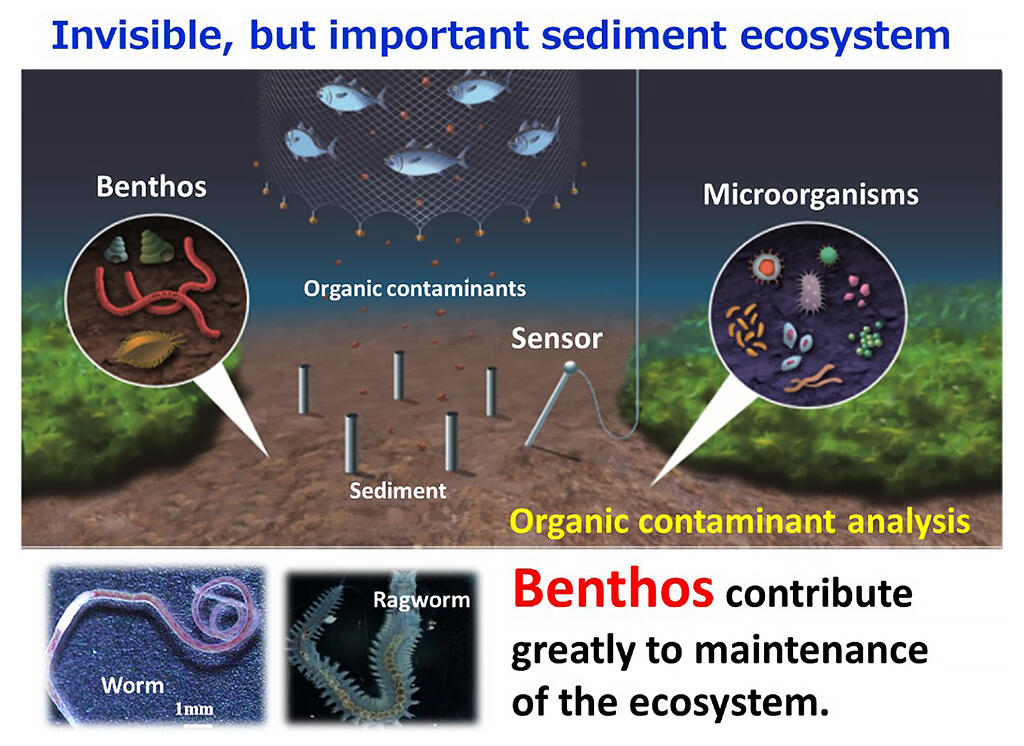A joint research group led by special researcher (at the time of the research) Nobuaki Shono and team leader Ryuhei Nakamura of the Biofunctional Catalysis Research Team, RIKEN Center for Sustainable Resource Science, team leader Jun Kikuchi of the Environmental Metabolism Analysis Research Team, RIKEN, and senior researcher Katsutoshi Ito of the Japan Fisheries Research and Education Agency, has successfully measured the electrical signals produced by marine worms in an aquaculture environment in real-time.

Various sensor technologies have been developed for environmental analysis in aquaculture farms in recent years, including by venture companies. However, the sediment environment under the aquaculture rafts, where administered feed accumulates, is still analyzed by manual bottom mud sampling. In collaboration with the Japan Fisheries Research and Education Agency, the group developed a sensor in 2015 that uses electro-microbiological readings to observe the activity of animals (benthos such as marine worms and ragworms) living in sediment to analyze its ecosystem, which is invisible but can become a source of disease and red tide outbreaks.
Sediment samples were collected from approximately 30 meters directly below the aquaculture rafts to use with this sensor. The samples contained living marine worms a few centimeters in length. These worms are highly resistant to hydrogen sulfide and can purify organically contaminated sediment. The samples were then placed in an electrochemical reactor to measure the worms' electrical signals.
When electrical potential measurements were initiated to obtain time series data on the environmental potential produced by the bottom sediment containing the marine worms, the potential increased with time, reaching about +400 millivolts. When 5 milligrams of feed was administered, the potential dropped sharply to near 0 volts but increased with time and eventually recovered to pre-feeding levels.
An excess amount (20 milligrams) of feed was also administered to see the change in environmental potential compared to the amount fed. Immediately after the feed was administered, the potential dropped to about -300 millivolts. Even after a week of measurements, the potential did not recover and remained negative at about -300 millivolts. These results indicate that the feed was administered in excess of the marine worms' capacity to purify the environment. The addition of 20 milligrams of feed to the bottom sediment caused the sediment to turn into sludge, and nearly all of the marine worms died.
The behavior of the marine worms was also examined while measuring the environmental potential. Before administering the feed, approximately half of the marine worms had their tails extending into the seawater, but when the feed decreased the potential, nearly all of the marine worms dove to the bottom sediment and buried themselves completely beneath it. When the potential began to recover, they returned to their original position with their tails extending into the seawater.
Finally, the group examined the behavior and metabolism of marine worms when the environmental potential was artificially altered using a test device. The results revealed that when the researchers altered the potential to be positive, the marine worms extended their tails into the seawater, and when the potential was set to negative, they buried their entire bodies in the bottom sediment. The group also observed reversible switching between aerobic and fumarate respiration (a type of respiration used in environments with low oxygen concentrations) in response to artificially altered potentials.
Nakamura said, "In the future, we would like to bring the technology we have demonstrated in the laboratory to aquaculture farms to demonstrate the usefulness of this technology in actual environments. We are also developing technology to provide information on when and how much to feed fish to aquaculture farmers utilizing IoT technologies. This information can then be transmitted, for example, to a smartphone."
Journal Information
Publication: Frontiers in Microbiology
Title: Tracing and regulating redox homeostasis of model benthic ecosystems for sustainable aquaculture in coastal environments
DOI: 10.3389/fmicb.2022.907703
This article has been translated by JST with permission from The Science News Ltd.(https://sci-news.co.jp/). Unauthorized reproduction of the article and photographs is prohibited.




